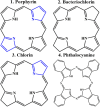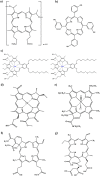Clinical development of photodynamic agents and therapeutic applications
- PMID: 30275968
- PMCID: PMC6158913
- DOI: 10.1186/s40824-018-0140-z
Clinical development of photodynamic agents and therapeutic applications
Abstract
Background: Photodynamic therapy (PDT) is photo-treatment of malignant or benign diseases using photosensitizing agents, light, and oxygen which generates cytotoxic reactive oxygens and induces tumour regressions. Several photodynamic treatments have been extensively studied and the photosensitizers (PS) are key to their biological efficacy, while laser and oxygen allow to appropriate and flexible delivery for treatment of diseases.
Introduction: In presence of oxygen and the specific light triggering, PS is activated from its ground state into an excited singlet state, generates reactive oxygen species (ROS) and induces apoptosis of cancer tissues. Those PS can be divided by its specific efficiency of ROS generation, absorption wavelength and chemical structure.
Main body: Up to dates, several PS were approved for clinical applications or under clinical trials. Photofrin® is the first clinically approved photosensitizer for the treatment of cancer. The second generation of PS, Porfimer sodium (Photofrin®), Temoporfin (Foscan®), Motexafin lutetium, Palladium bacteriopheophorbide, Purlytin®, Verteporfin (Visudyne®), Talaporfin (Laserphyrin®) are clinically approved or under-clinical trials. Now, third generation of PS, which can dramatically improve cancer-targeting efficiency by chemical modification, nano-delivery system or antibody conjugation, are extensively studied for clinical development.
Conclusion: Here, we discuss up-to-date information on FDA-approved photodynamic agents, the clinical benefits of these agents. However, PDT is still dearth for the treatment of diseases in specifically deep tissue cancer. Next generation PS will be addressed in the future for PDT. We also provide clinical unmet need for the design of new photosensitizers.
Keywords: Clinical trials; Clinical unmet need; Photodynamic therapy; Photosensitizers; Porphyrins.
Conflict of interest statement
Not applicable.All authors have consented to the submission of this manuscript for publication.The authors declare that they have no competing interests.Springer Nature remains neutral about jurisdictional claims in published maps and institutional affiliations.
Figures



References
Publication types
LinkOut - more resources
Full Text Sources
Other Literature Sources

